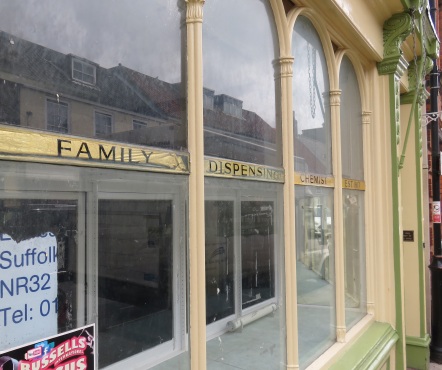
Butler, Son & Co., High Street, Leicester (1903)
The Mortar and Pestle
The mortar and pestle has been used by apothecaries, chemists and druggists for centuries to grind medicinal powders. It remains one of the chemist’s favourite symbols, depicted on shop signs to proclaim the nature of the business. A stylised mortar and pestle forms the current logo of one of Britain’s largest pharmacy chains, Lloyds.

Dispensing Pharmacy, Royal Mile, Edinburgh
Sometimes a large mortar and pestle projects from the frontage of the building above the shop. Whether this is made of wood, stone or metal it usually has the appearance of bell metal – despite porcelain being recognised as a preferable material from the late 18th century. Mortars often have a red cabochon affixed (does anybody know why?).
The Caduceus and the Rod of Asclepius/Aesculapius
These two classical symbols are often muddled. In Greek mythology, the caduceus is the staff carried by Hermes, the messenger of the gods. Two snakes entwine around a rod, which is topped by a pair of wings. This eventually became associated with commerce.

Lloyd’s Pharmacy, Warwick Road, Carlisle
The caduceus of Hermes is often confused with the rod of Asclepius or Aesculapius, the Greek god of medicine, which comprises a single snake winding around a staff. Both symbols can be found adorning 19th– and 20th-century chemists’ shops throughout the United Kingdom.
Carboys and Carboy Shelves

136 High Street Dorking before conversion into a barber’s shop. The carboy shelf (shown here) has been removed.
Since the advent of plate glass for shop windows around 1840 it has been common for chemists to fill carboys – large globular bottles of colourless glass – with brightly coloured liquid and arrange them on a shelf at the top of their shop windows. Sometimes the carboys are accompanied by fat specie jars, which may be elaborately gilded and decorated with arms.

Clowes Pharmacy, Buxton
Rather than corresponding to a moulded transom bar, the outer edge of the carboy shelf on Victorian chemists’ shops was often masked by a band of black-on-gold lettering.

Robert Morris’s chemist’s shop, 59 High Street, Lowestoft, 1851
It is increasingly rare to stumble across old-fashioned chemists’ shops which still use carboy shelves for their original purpose. Often, however, when a chemist’s shop has been taken over by a different trade the carboy shelf survives, betraying its historic origins.

Former Chemist’s, High Street, Lewes
Carboys can also be found depicted as two-dimensional symbols on signage and on window glass.

Illuminated box sign advertised by the London shopfitters E. Pollard & Co. Ltd., 1930s
Advertisements for Patent Medicines
From the mid-Victorian period to the mid-20th century, the façades of some chemists’ shops were covered in semi-permanent advertisements for patent medicines. These could be executed in plaster relief, in pictorial tiles (see the advertisement for Sea Breeze saline solution above) or — more commonly — simply painted onto the wall surface. An advertisement for Idris mineral water was gilded onto the glass over the door of Woodcock’s former shop in Dorking (see above).

High Street, Berkhamsted (now an estate agent’s)
Spectacles
Both jewellers and chemists frequently combined their core trade with that of the optician. In each case this service could be advertised by signs depicting spectacles.

Boots, Sheringham, Norfolk
The Green Cross
Used for many years to signal the presence of pharmacies in France and other European countries, the green cross is an increasingly common sight on British streets. It has been adopted, amongst others, by Boots.

Lincolnshire Co-op Pharmacy, Aberdeen Walk, Scarborough.

Our local chemist’s shop has a small red ‘flame’ lamp hung above the entrance door – I’ve been told this was illuminated when the chemist was in – can you confirm if that’s true?
LikeLike
I hope somebody can confirm this for you – it’s not something I’ve come across!
LikeLike
Lovely photo of Woodcock’s in Dorking High Street! Such a shame it’s gone. As a child in the 70’s it really was a fascinating (and slightly scary I seem to remember) place to go into. They kept all the old bottles and potions around very high up shelves. I wonder what happened to those huge, pointed glass bottles they had. They probably weren’t that high I was just very short! The dispensing hatch was high up too, a sort of box room up some steps. I left Dorking in 1993 but I don’t think the place changed that much in that time. Alan Woodcock was born in 1904 I believe (I only remember that as my grandmother was 1904 too), so presumably his son then took it over, and I think it went when he retired.
LikeLike